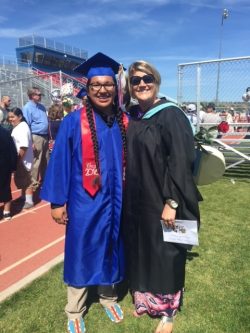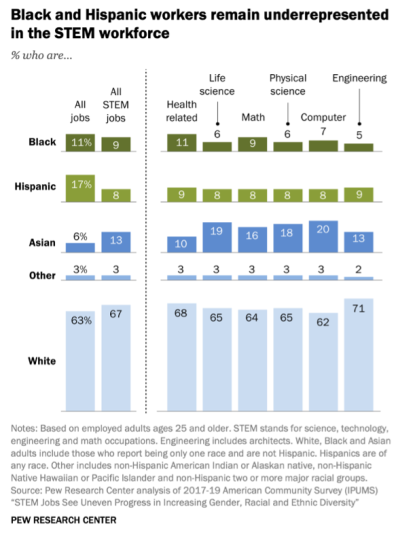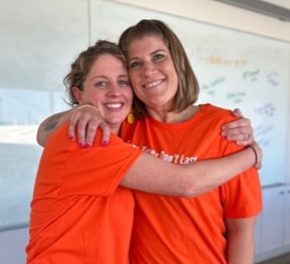STEM + CTE: Mutually reinforcing paths to success

Author:
Angie Mason-Smith
Angie is Washington STEM’s Program Director for Career Pathways.
Things that (actually) go well together: Peanut Butter and Bananas. Pickles and Ice cream. CTE and STEM.
CTE, career technical education, are skill-based classes that prepare youth for high wage, high demand careers, such as IT, medical training, manufacturing, etc. Whatever you call it, at its core, CTE is good STEM education. It is hands-on problem-solving, inquiry-based learning, and should be a part of any school’s strategy to bring more students into STEM careers—the fastest growing job market.
I’d know—in many ways, I’ve lived my life at the intersection between CTE and STEM.
And to be honest—sometimes it pinches a little.

My career: a zigzag between STEM and CTE
I started working in my family’s irrigation business in Central Oregon at a very young age. Early mornings were spent counting inventory, or putting together spokes and frames for wheel lines or side rollers that move sprinkler systems. I spent many a hot summer out in fields, digging trenches and installing irrigation systems with my brother and pulling a 40’ pipe trailer with my sister. As my parents grew the business, I watched how they kept up with the changing technology and continued to learn and grow to meet the demands of modernization in the agriculture industry.
I was also a very dedicated volleyball player, and every fall my teammates would ask about my summer training program. My answer was always the same: “Manual labor.” Although I considered majoring in business and returning to the family business, my love of volleyball and athletics led me in another direction. After I had my son in 2014, I made the career switch to Education and became a CTE instructor. I taught Business Administration courses—but through a sports lens. Students signed up in droves to take sports marketing and sports management, learning business concepts through a mechanism that interested and engaged them. I soon joined the regional Education Service District (ESD) to support more CTE teachers to engage with industry and innovate programs.
I taught Business Administration courses—but through a sports lens. Students signed up in droves to take sports marketing and sports management, learning business concepts through a mechanism that interested and engaged them.
Then I made the monumental shift to the “other side” and became executive director of the Central Oregon STEM Hub, where I engaged industry, postsecondary, and K-12 partners, and community-based organizations. Together we assessed gaps and created learning experiences to inspire students to become innovators and prepare them to solve the challenges of tomorrow.
But wait… isn’t that what CTE wants as well?
Despite this shared goal, I started to notice a tension between CTE and STEM. I called for closer collaboration and alignment between our STEM and CTE friends. After a few years, I pinballed back to CTE, this time as the Core Plus Program Coordinator in the Washington State Office of Superintendent of Public Instruction’s CTE department.

And now, I’m back in STEM, as the Director of Washington STEM’s Career Pathways program. A highlight of my time here has been helping address the tension between CTE and STEM by serving on the board of Washington Association of Career and Technical Administrators (WACTA) and to strengthen partnerships and collaboration at the state level. CTE and STEM used to be in competition and adversarial, but now this collaboration has them working in lockstep and in support of one another. My colleague, Margaret Rice, is President of WACTA and CTE Director of the Washougal School District. She noted, “Not only is STEM a part of every CTE program but STEM holds its own pathway in CTE Programs of Study. All CTE Teachers and now Administrators are required to have professional development within STEM as part of their certification renewal.”
It’s time to valorize CTE and STEM the same
Valuing CTE and STEM equally as viable career pathways is the work we do to break down the silos and competition between them. To my surprise, here at Washington STEM, I don’t actually talk about STEM very much—we talk about well-lit pathways for 1-2-year certificates, 2- and 4-year degrees and/or apprenticeships. I talk about students gaining “transferable skills” that open a variety of doors.
A student who completes a phlebotomy course can get an in-demand job—one that could also prepare them for pre-med college courses.
These relate to both CTE and STEM. For example, a CTE course in the medical field allows for career exploration –“Do I want to be a medical assistant, or work my way up to physician?”— while gaining skills, like taking a patient’s history, or overcoming squeamishness with blood. A student who completes a phlebotomy course can get an in-demand job—one that could also prepare them for pre-med college courses.
Another example is Boeing’s Core Plus Aerospace curriculum. Since 2015, it’s grown from 8 to 50 schools, teaching 3000+ high school students the skills needed to build airplanes. Graduates who sign with Boeing earn an average of $100,000 in salary and benefits, and the others will replace retiring Baby Boomers in other industries across the state. And for those at Boeing, it’s a foot in the door that can lead to additional higher education in STEM.
It’s time to valorize these in-demand CTE pathways so all students—or the trusted adults in their lives—realize they can lead to challenging and household-sustaining careers.
When I taught CTE courses, I had a student who LOVED accounting. She was so advanced beyond the curriculum I had to create spreadsheets at night for her to balance the next day. One day she came to me crying because her parents wanted her to quit accounting and take more science courses so she could be pre-med in college and become a doctor. They said they had sacrificed so much for her to succeed—and in their mind that meant becoming a medical doctor. She invited me to have a tough conversation with her family and help them see she could have a good career if she continued into accounting. We talked about what paths were open to her—and I’m glad to report, today she has a Bachelors in Business Administration and is happily working in the financial department in a Portland hospital.
It’s time to valorize these in-demand CTE pathways so all students—or the trusted adults in their lives—realize they can lead to challenging and household-sustaining careers.
…outdated perception among adults that CTE leads to blue-collar jobs and STEM courses lead to white-collar jobs or advanced degrees. With all the technological advancements in the 21st century workplace, these kinds of categorizations are no longer relevant.
Deciding who’s “college material”
While one’s parents can be influential in a student’s pathway, research has shown that most students get their information from teachers, career counselors or a trusted adult in their school building. They rely on in-school support when they work on their High School and Beyond Plan.
So when a trusted adult directs a student into a particular career pathway based on unsupported assumptions about who is “college material”—this results in unequal outcomes. Our recent High School to Postsecondary project provides an example of this from Eisenhower High School in Yakima where the data showed male, Latino students were overrepresented in agricultural-related CTE courses, while white students were over-represented in the CTE courses leading to the trades.

These findings reflect an outdated perception among adults that CTE courses lead to blue-collar jobs and STEM courses lead to white-collar jobs or advanced degrees. With all the technological advancements in the 21st century workplace, these kinds of categorizations are no longer relevant. Both CTE and STEM train students to engage in critical thinking, problem-solving, collaboration, or design-thinking. Both are responsive to employers and the global economy at large and prepare students for the 21st century workplace.
Recognize and overcome your Adult Bias
At the same time, these ‘trusted adults’ need to examine and be aware of their own biases related to race, gender, ethnicity, geographic background or class, so they don’t unwittingly cause harm.
Now, I have great respect for teachers and career counselors—I’ve been one. I’ve spent many years counseling athletes to improve their academic performance. But I remember—painful as it is to recall—many times when my unintentional bias influenced how I advised students. When I assumed a student-athlete was not smart enough or they didn’t care about academics, I’d recommend classes that might get them the grades to remain eligible to play sports—even if it didn’t align to their actual academic aspirations. I remember being surprised when one of my football students received early admittance into the University of Washington’s Foster School of Business, a program that is highly competitive and hard to get into straight out of high school. I remember him calling out the shock on my face that said a football player couldn’t also be an all-star academic.
Since then, I’ve come to recognize my own blinders and I try to correct for that. Those biases we show as adults while helping students navigate pathways can be so incredibly harmful and we all have to work to fight against stereotypes and assumptions and get to know the individual students and their unique career goals.

So, it’s with love that I call on all ‘trusted adults’—teachers, career counselors, administrators—to examine any unintentional biases. Start here. Doing so can make a huge difference for a student who just needs one adult to ask about their aspirations and encourage them, so they can chart their own course—whether enrolling in a CTE course, like a maritime training program, or applying for early admission to a prestigious business school.
It’s not an easy thing—examining one’s bias. But if you are able to support students from a wide range of backgrounds as they build academic confidence, take steps towards a career or education goal, and emerge out the other side as lifelong learners—that’s the win.